First use
PREPARING YOUR MOUNTAIN BIKE
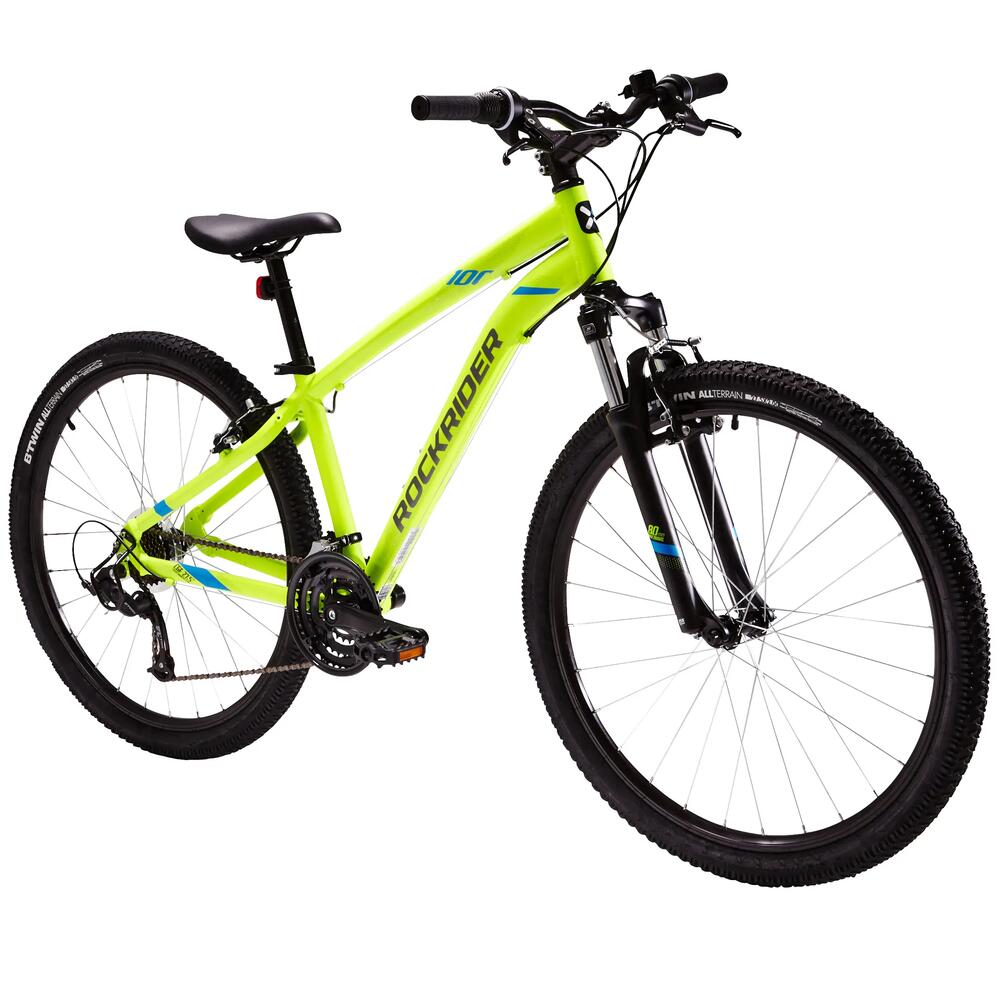
REF: 8400336, 8400335
2020
Designed to help you break new ground on your first forays into mountain biking. Push yourself and have fun as you take on the obstacles in your path and soak up nature. Putting your comfort first and giving you an easy ride: CGF frame with upright riding position, 80mm suspension, ErgoFit hammock saddle with Flex seat post and 27.5" wheels (26" in XS).
PREPARING YOUR MOUNTAIN BIKE
The recommended average tyre pressure is 2.5 bar. To be more exact, the ideal tyre pressure is determined by the weight of the user. Inflating your tyres in accordance with your weight will help you strike the right balance between performance and the ability of the tyres to avoid punctures and the pinching of the inner tube. You'll find your ideal tyre pressure in the table on the walls of your tyres. If you're looking for more grip, you can reduce the pressure by 10% but without dropping below 2 bar (the minimum recommended pressure). On abrasive terrain, however, this will increase the risk of punctures. You should check the pressure of your tyres regularly.

Your handlebar is set in the highest position to help keep your back raised, which is the most comfortable position for riding. For improved aerodynamics and more effective pedalling, you can lower your handlebars to lower your body. This will cause you to lean forward and adopt a racing position. Follow the steps in this video to move the headset spacers below the stem and lower the handlebars on your bike.
HOW TO ADJUST THE HEIGHT OF YOUR HANDLEBARS?
Your ST 100 bike frame is fitted with a quick-release lever. Stand next to your saddle. Tilt the quick-release lever to unlock it. Pull the saddle up or push it down to bring it level with your pelvis. Tilt the lever again to lock it. To make sure you get it right take a look at our tutorial video.
HOW TO ADJUST THE HEIGHT OF YOUR SADDLE?
Your SUNTOUR XCT fork has two preload barrel adjusters. They are separate to each other. Try adjusting the fork just with the first one. If the preload level is insufficient even when the first adjuster is screwed right down, you can always use the second to finish adjusting the fork. Turn the adjusters clockwise to increase the stiffness of the fork and anti-clockwise to reduce it.
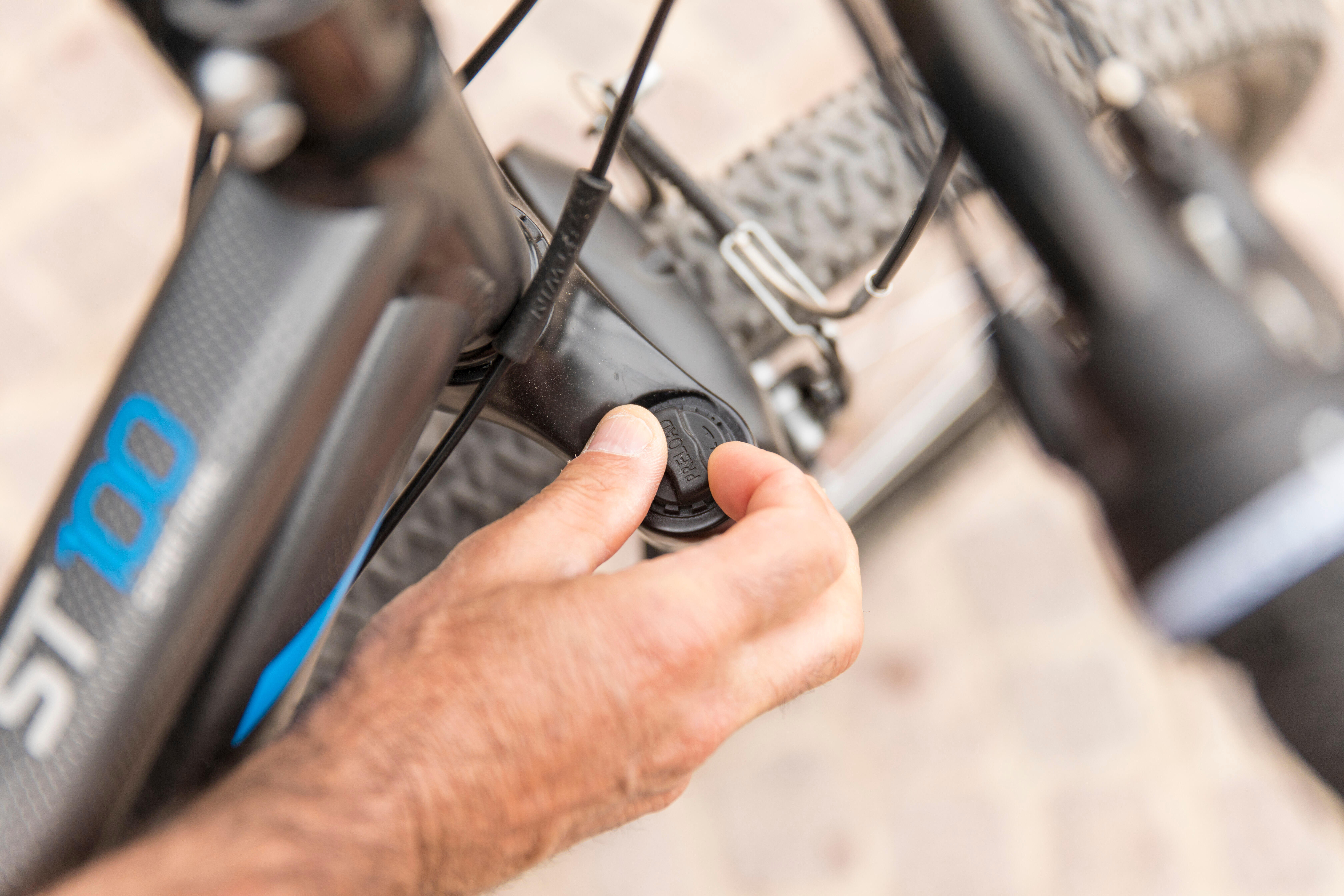
There's no need to bed in your V-brakes and pads. You should know, however, that when the pads come into contact with the black trim on your rims for the first time it will make quite a noise. Don't worry, though. As you use your bike and apply the brakes more and more, a fine film of rubber will form over the rims and the noise will gradually disappear.
Your ST 100 mountain bike has been designed to help you break new ground on your first forays into mountain biking, thanks to specially adapted V-Brake technology. Unfortunately, you can only fit your bike with disc brakes if you change the fork (for the front brakes) and frame (for the rear brakes).
Your ST100 mountain bike is available in five sizes, from XS to XL. With the smaller sizes (XS and S), fitting accessories such as the stand, mudguards and child seat may prove difficult. We therefore recommend that you fit your mountain bike with the following accessories. We guarantee they are 100% compatible.
ACCESSORIES COMPATIBLE WITH THE ST 100 MOUNTAIN BIKE

You need to have the right equipment with you when you're out and about on your mountain bike so that you can take care of a puncture, a broken chain or any other type of setback. Here's a selection of products that can get you out of a tight spot or two.
There are several things you can do to ensure your front gears shift properly:
1. Check the position of the housing ends:
1a. Housing ends that are out of position can obstruct the derailleur cable when it is being pulled and prevent the gears from shifting smoothly.
If a housing end is out of position, push it back into place.
1b. If the derailleur doesn't move even when the gear shifter is operated, then the cable and the housings have probably jammed up. You will need to have the cable and housings replaced.
2. Take your mountain bike to a DECATHLON workshop to have the derailleur adjusted. REMEMBER: You can have all the settings on your bike checked for free in the first six months following the date of purchase.
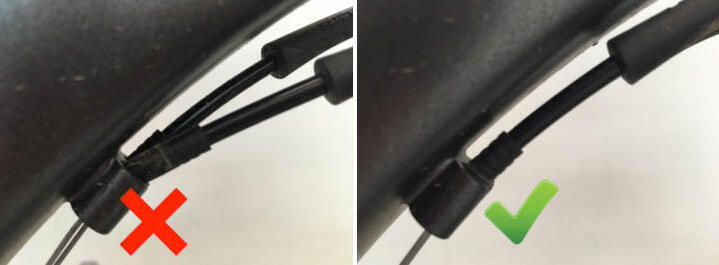
When you take your new bike out for a ride for the first time, a lot of parts move around and fall into place.
You'll hear the spokes on your wheels creak because of the residual torsion in them.
Your bike (from size S upwards) is fitted with double-walled rims, which help make the wheels more solid. That means they should not buckle in any way at all. If they do, then call in at one of our DECATHLON workshops to have them repaired free of charge.
Message for parents:
Young riders like to do tricks on their bikes (wheeling, skids, jumping off kerbs, etc). If done too often, however, they can cause play in the rear hub and buckle the wheels. If your child performs these tricks on a regular basis, speak to them and let them know the problems they can cause.
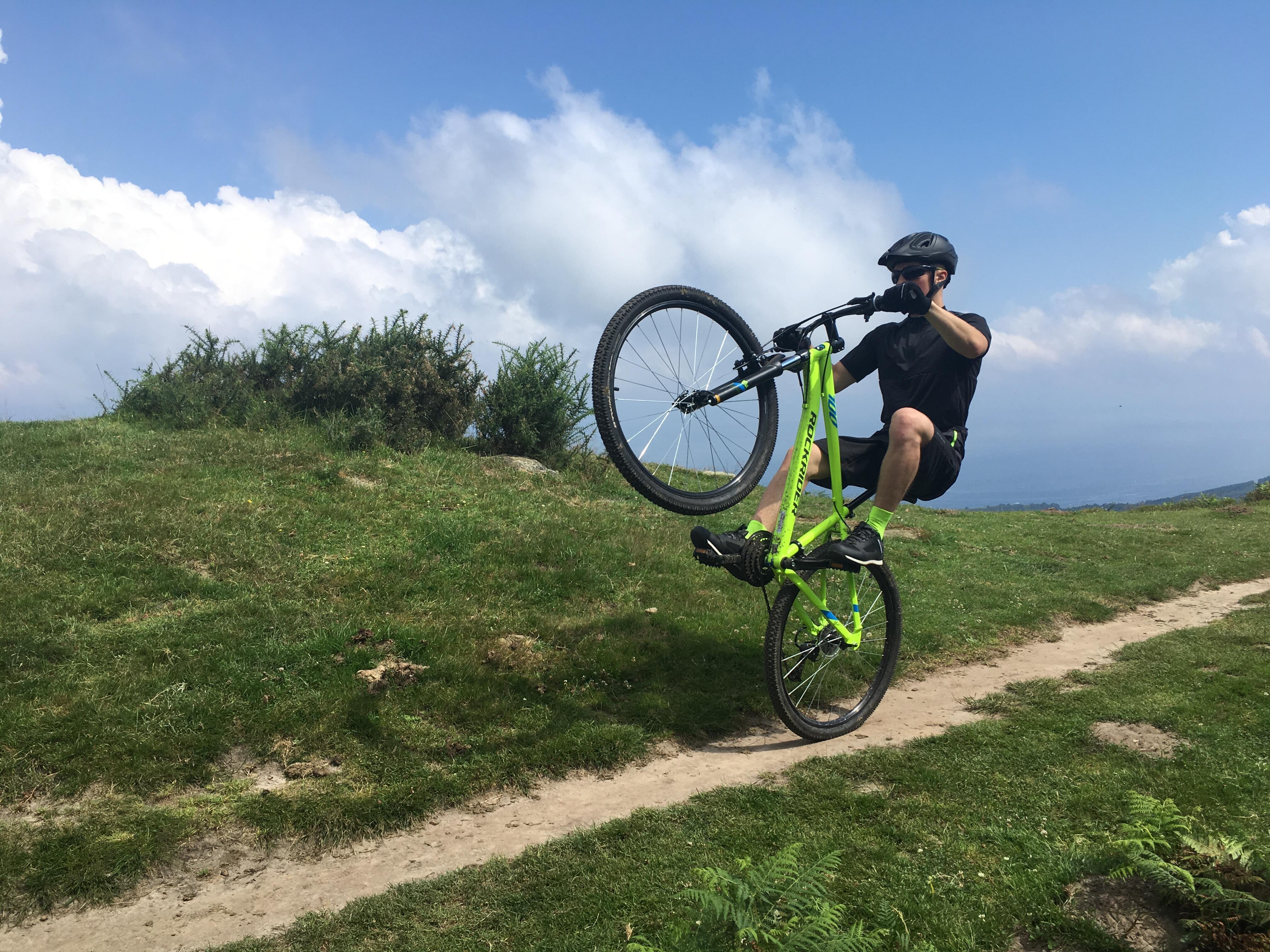
Your suspension fork operates best when the temperature is 5°C and over.
Below this temperature, the suspension can stiffen and even lock up, but without suffering damage.
It will start to function normally again when the temperature rises above 5°C.
If you detect a fault, however, or you are not sure if your fork is in good condition, take it to your nearest DECATHLON workshop and have it checked straightaway.
It's a sad fact of cycling that everyone gets punctures. And it doesn't just come down to what type of tyre or inner tube you use.
That said, it's not normal to suffer punctures over and over again. If you do, then there are several possible reasons:
- The wheel has not been assembled properly in the factory and a spoke keeps piercing the inner tube.
- A substandard tyre or inner tube.
- A badly repaired puncture or a foreign body (thorn, piece of glass, shard of metal, etc) stuck on the rim or in the tyre.
It's important to check that there aren't any foreign bodies in the tyre and rim.
I don't know how to put a tyre on or take one off so how am I going to repair or change an inner tube?
The simplest thing to do is not to touch your wheel and use a can of puncture repair foam as a temporary solution: Screw the end of the tube on to the valve of the punctured tyre (with the valve pointing down) and press down to inject the foam. The tyre will regain its shape and hardness, allowing you to get home.
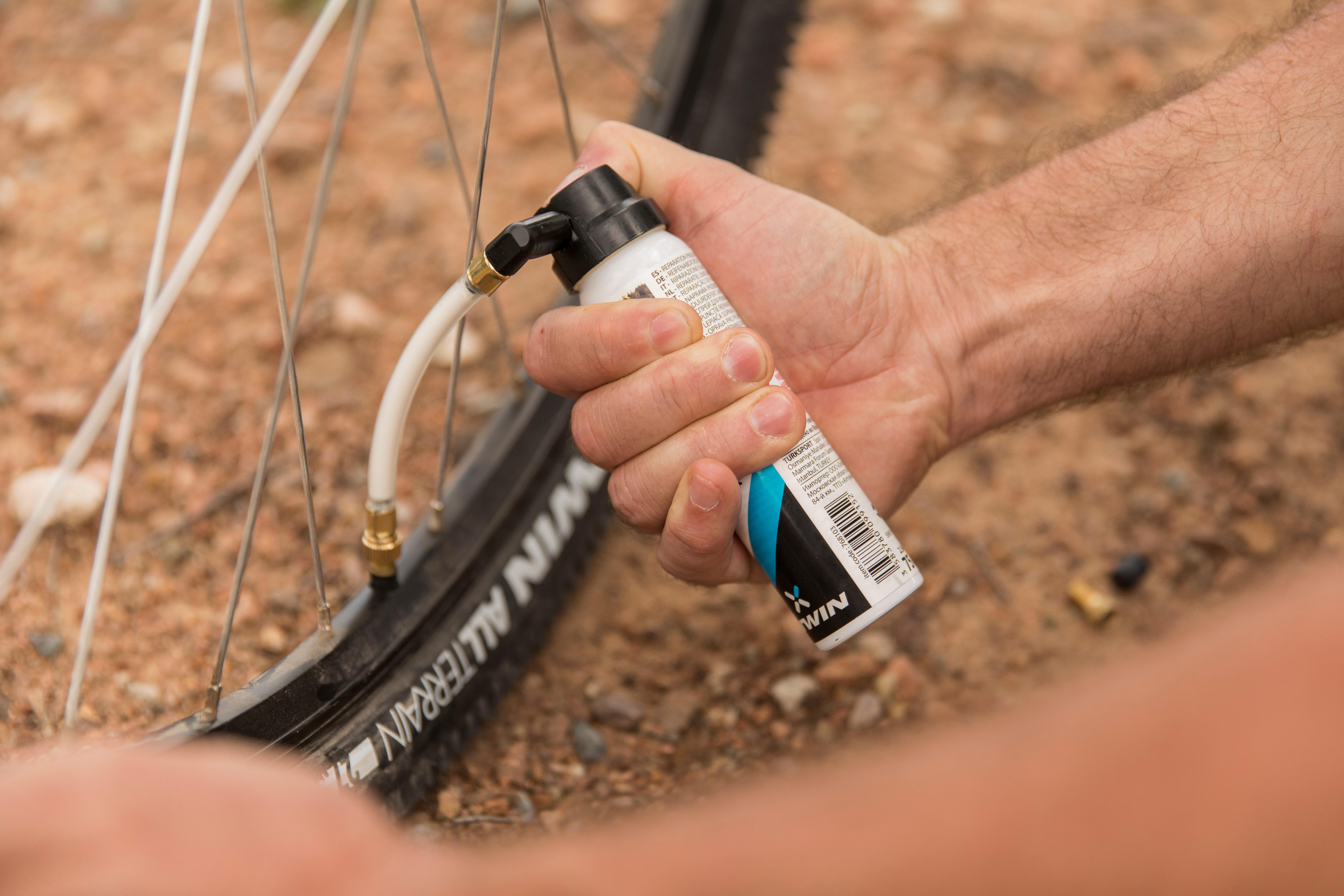
There are one or two things you can do to make your fork "softer":
1. Adjust the stiffness: check the section "ADJUSTING THE STIFFNESS OF YOUR FORK"
2. Do some basic maintenance: using a simple oil can. Squirt some oil on the pivots of the fork and move it around to work the oil into the blades.
3. Have the bike fully serviced in a workshop.
You should know that when the brake pads come into contact with the black trim on your rims for the first time it will make quite a noise. Don't worry, though. As you use your bike and apply the brakes more and more, a fine film of rubber will form over the rims and the noise will gradually disappear.
There are several things you can do to ensure your rear gears shift properly:
1. Check the position of the housing ends:
1a. Housing ends that are out of position can obstruct the derailleur cable when it is being pulled and prevent the gears from shifting smoothly. If a housing end is out of position, push it back into place.
1b. If the derailleur doesn't move even when the gear shifter is operated, then the cable and the housings have probably jammed up. You will need to have the cable and housings replaced.
2. Check that the derailleur dropout is not twisted: A twisted dropout causes the derailleur to become misaligned, preventing it from doing its job correctly. Look at your bike from behind and check to see if the derailleur is straight, as shown in the image below.
If the dropout is twisted or broken, take your bike to a DECATHLON workshop to have it replaced.
3. Take your mountain bike to a DECATHLON workshop to have the derailleur adjusted. REMEMBER: You can have all the settings on your bike checked for free in the first six months following the date of purchase.
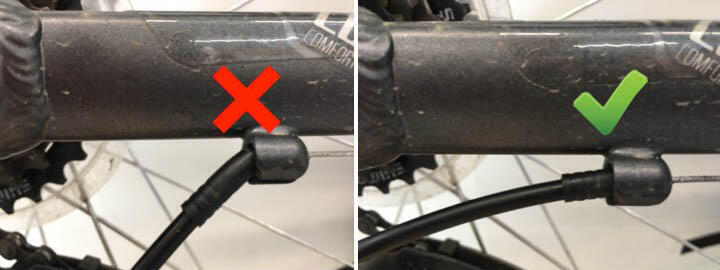
These videos show you how to repair your bike and replace parts yourself.
- Putting on/taking off a rear wheel - Repairing a puncture
- Changing an inner tube - Adjusting the height of the handlebars
- Repairing a chain - Replacing a derailleur dropout
Our YouTube channel has a lot more content. Have a good look around.
PUTTING ON/TAKING OFF A REAR WHEEL
To clean your bike properly, you'll need some bike cleaner, a sponge and a brush. Spray the bike with a hose before applying the cleaning products. Use the sponge and brush to apply the products. Allow the product to act before rinsing the bike. Rinse it from a distance to avoid damaging mechanical parts. Finally, dry the bike with a soft, clean, dry cloth.
CLEANING YOUR MOUNTAIN BIKE
To clean and lubricate your drive train, you will need a degreaser spray, a soft bristled brush and a lubricant. The first step involves covering the brake disc with a clean cloth to prevent any lubricant from getting on to it. Then apply the degreaser to the whole of the drive train and scrub the cassette, chain and derailleur jockey wheels with the brush. Leave to act for a few minutes before rinsing the degreaser off from a suitable distance. Allow the drive train to dry before applying the lubricant. Shake the lubricant and apply to the inside of the chain, where it will work best.
CLEANING AND LUBRICATING THE DRIVE TRAIN
Is your drive train cable dirty, rusty or damaged or are your gear changes stiff, random or not as slick as they should be? If so, the cable needs changing. You'll need a pair of pliers, a screwdriver, cable cutters, an Allen key and a new derailleur cables and housings kit. Start by removing the cable from the housing. Remove the hood from the gear shifter, move the indicator to the last gear and cut the cable. This will allow you to remove all of the cable and then the housing. Cut the housing to size and fit the end caps on the end of the cable, which is now ready to fit. Thread the cable through the shifter and push it through the housing. Then put the hood back on the shifter and attach the cable to the derailleur. To adjust the drive train, tighten the cable if the gears do not shift up easily and slacken it if they do not shift down smoothly. Finally, cut the cable and use the pliers to attach the end cap to it.
CHANGING A DRIVE TRAIN CABLE
TAKING OFF THE REAR WHEEL
You need the following to repair a puncture: a pump, a basin of water, a cloth and an inner tube kit. Put a little pressure on the inner tube. To find the puncture, submerge the inner tube in the basin of water. Once you've spotted it, dry the inner tube with a cloth and scrape the area around it with the sandpaper provided in the kit. Scraping the inner tube will allow the glue to adhere better. Apply the glue generously around the hole and wait for three to five minutes. Place the patch over the hole and hold it there for a few minutes. You can then fit your inner tube back into the tyre.
REPAIRING A PUNCTURE
You will need the following: a chain tool, a new chain and a quick-release link. Put the chain on the cog and on the smallest chainwheel. Remove the quick-release link using a quick-release chain tool and then remove the chain from the drive train. Put the new chain on the last of the cogs and on the smallest chainwheel. This makes it easier to determine its optimal length. The chain should pass close to the top pulley of the upper jockey wheel on the derailleur. Once you've determined the length of the chain, use the chain tool to cut it as required. Then fit the quick-release link on the chain and turn the pedal to position the quick-release lever on the top part of the chain. Press it with your hand to check that it is on the right position.
CHANGING A CHAIN
CHANGING THE BRAKE PADS
Maintaining your ST 100 MOUNTAIN BIKE
Fit your ST 100 mountain bike with the following accessories. We guarantee they are 100% compatible.
Need to change some parts? You'll find all our spare parts for the ST 100 MOUNTAIN BIKE Yellow right here.
Instructions
Suspension
Suspension instructions
Drive train
Drive train instructions

Please contact one of our technicians who will be happy to help

ROCKRIDER guarantees the frame, handlebar and stem of your mountain bike for life (in normal conditions of use).
The guarantee for other parts is two years.
As soon as your child starts using the bike, some components will move slightly. It's for that reason that we offer a free check of your mountain bike six months after purchase.